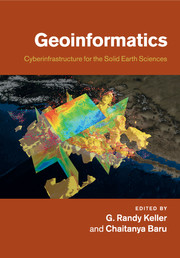Book contents
- Frontmatter
- Contents
- List of contributors
- Preface
- Introduction
- Part I Case studies from other disciplines
- Part II Modeling software and community codes
- Part III Visualization and data representation
- Part IV Knowledge management and data integration
- Part V Web services and scientific workflows
- Part VI Emerging international and other efforts
- 18 It's not your data, it's everyone's: The benefits of a corporate approach to scientific information
- 19 TOPO-EUROPE and cyberinfrastructure: Quantifying coupled deep earth – surface processes in 4-D
- 20 OneGeology – from concept to global project
- 21 Geoinformatics developments in Germany
- 22 iGEON: Networking the Indian geosciences community through GEON
- 23 Geoinformatics in the public service: Building a cyberinfrastructure across the geological surveys
- 24 Application of the US Geoscience Information Network to deploying a national geothermal data system
- Index
- Plate section
- References
21 - Geoinformatics developments in Germany
from Part VI - Emerging international and other efforts
Published online by Cambridge University Press: 25 October 2011
- Frontmatter
- Contents
- List of contributors
- Preface
- Introduction
- Part I Case studies from other disciplines
- Part II Modeling software and community codes
- Part III Visualization and data representation
- Part IV Knowledge management and data integration
- Part V Web services and scientific workflows
- Part VI Emerging international and other efforts
- 18 It's not your data, it's everyone's: The benefits of a corporate approach to scientific information
- 19 TOPO-EUROPE and cyberinfrastructure: Quantifying coupled deep earth – surface processes in 4-D
- 20 OneGeology – from concept to global project
- 21 Geoinformatics developments in Germany
- 22 iGEON: Networking the Indian geosciences community through GEON
- 23 Geoinformatics in the public service: Building a cyberinfrastructure across the geological surveys
- 24 Application of the US Geoscience Information Network to deploying a national geothermal data system
- Index
- Plate section
- References
Summary
Geoinformatics history in Germany
With computers becoming available for geosciences in the 1970s, the German research community in the earth sciences realized the potential of an informatics approach to scientific questions in the earth sciences. As early as 1979, groups started investigating how these “new media” could be used in earth science research (Vinken, 1983). The development of applications in the mid 1980s was driven mainly by the needs of land surveying and those of utility companies. By the end of the 1980s, the application of Geographic Information Systems (GIS) began to establish itself as a methodology in academic research, predominantly in the fields of geodesy and geography. However, progress in the field of geoinformatics was hampered by missing standards and immature technology. The term geoinformatik for the application of computer science in the earth sciences has been in use in Germany since the mid 1990s. However, its definition remains vague and other terms, such as “geoinformation science” and “geomatics” are still in use.
In the early 1990s, the German National Science Foundation (Deutsche Forschungsgemeinschaft, DFG) established a working group for interoperable GIS (AG IOGIS). The concept of IOGIS can be seen as a precursor to an interoperable geospatial infrastructure. This was also the time when geoinformatics began to establish itself as a subdiscipline of computer science and to reach beyond GIS as its application.
- Type
- Chapter
- Information
- GeoinformaticsCyberinfrastructure for the Solid Earth Sciences, pp. 323 - 331Publisher: Cambridge University PressPrint publication year: 2011

